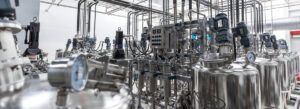-
CAS75-18-3
-
Structural formula
(CH₃)₂S
Remove dimethyl sulphide from exhaust air
What is dimethyl sulphide?
Dimethyl sulphide (DMS) is a colourless liquid with a characteristic unpleasant odour, similar to that of rotten eggs or cabbage. It occurs in small quantities in the environment and is released by biological processes in the ocean. In industry, it is used as a solvent and intermediate in chemical synthesis.
Creation
Dimethyl sulphide is mainly formed by biological processes in the sea, where it is produced by microorganisms. Industrially, DMS is released during the production of pulp and paper, in the petrochemical industry and in the food industry. It is also formed during the decomposition of organic matter in agricultural processes.
Detection
Dimethyl sulphide is easily recognisable by its strong, unpleasant odour, which is reminiscent of rotten eggs or rotting plants. It is a colourless liquid that can cause irritation if it comes into contact with the skin or is inhaled. The intense odour makes it easily perceptible even in low concentrations.
Limit values
In Germany, the limit values for dimethyl sulphide are regulated by the Technical Instructions on Air Quality Control (TA-Luft) and the occupational exposure limit values (OEL). The OEL for dimethyl sulphide is 10 ppm (parts per million) or 25 mg/m³. These limit values are intended to ensure that the concentrations in the workplace do not cause any damage to health.
Hazards
Health: DMS can irritate the eyes, skin and respiratory tract. High concentrations can cause headaches, dizziness and nausea. Prolonged exposure may cause serious health damage. Environment: DMS contributes to the formation of sulphate aerosols, which can affect the climate. It is harmful to aquatic organisms in high concentrations. Economic damage: Improper handling and release of DMS can lead to high costs for environmental and health protection measures.
The oxytec Purification Technology
For many organic pollutants, we offer energy-saving and clean technologies for neutralisation, which we combine in multi-stage plants. In order to achieve a reduction below the limit values, not only the dimensioning of the respective purification stage but also the sequence of the technologies is decisive, as they have different physical effects on the molecules. Below we present some of our purification modules.
CWA
Alternative technologies
Other technologies such as conventional activated carbon filters and simple ventilation systems often have disadvantages such as high energy consumption, limited cleaning performance, large space requirements, long lead times and high investment costs.
Advantages of the oxytec solution
- Compact design: Small footprint compared to traditional systems.
- Fast amortisation: Thanks to low operating costs and high efficiency.
- Environmentally friendly: Minimal environmental impact thanks to innovative technologies
- Efficient amine reduction: High purification levels with minimal energy consumption.
